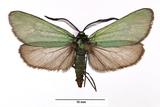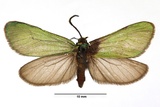Jordanita globulariae (Hübner, 1793) Species
Last modified: Nov. 4, 2023, 11:21 a.m.
A very rare and declining species in the southern part of Belgium, not seen for a while.
Details
- Classification
- Family: Zygaenidae > Subfamily: Procridinae > Genus: Jordanita > Subgenus: Jordanita > Species: Jordanita globulariae
- Vernacular names
- Prachtmetaalvlinder (NL), Scarce Forester (EN), La Turquoise de la Globulaire, le Procris des Centaurée (FR), Flockenblumen-Grünwidderchen (DE)
- First mention in Belgium
- De Sélys-Longchamps E. 1837. Catalogue des Lépidoptères ou Papillons de la Belgique, précédé du tableau des Libellulines de ce pays. — — : 1–29. On page 23 (as Procris Globulariae). view page
- Status
-
Native
Distribution
Imago
Wingspan c. 19–30 mm. The antennae of the male is more tapered than the blunt-ended antennae of Adscita statices.
Mine
The larva begins by making a tiny full depth corridor. When the larva becomes bigger it starts living free. A number of times it makes a transverse slit in the lower epidermis, then it eats away the leaf tissue, penetrating into the mine with the frontal part of its . This is resulting in a number of fleck mines, without frass, with the opening in the form of a large, lateral slit. The larva mines till just before the pupation, that takes place externally.
Bionomics
The moths are active during the day.
Flight periods
The adults fly mainly during June.
Observed on
- Host plant (genera):
- Centaurea
The polyphagous larva feeds on different species of Centaurea and on Cirsium.
Habitat
It inhabits calcareous soils and grasslands.


